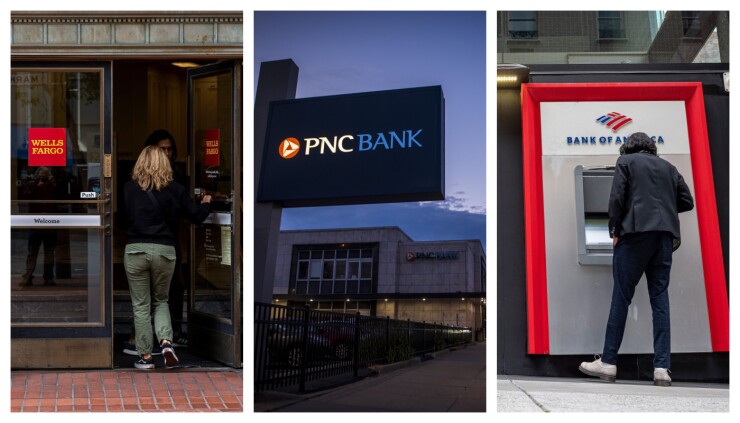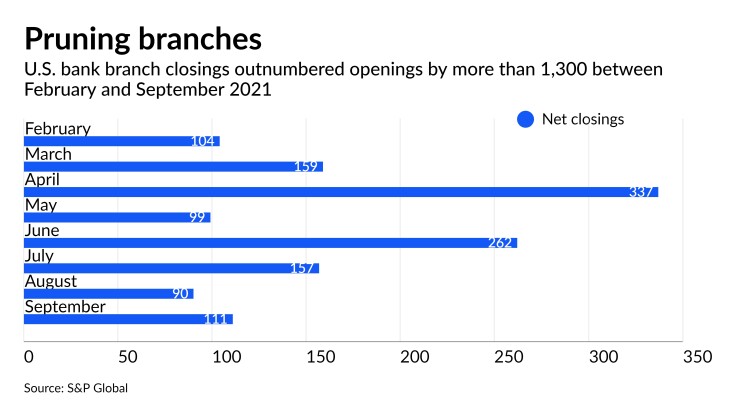Even as big banks continue to trim their branch networks, they’re targeting opportunities to open new locations, suggesting that pandemic-induced changes in consumer behavior have not fundamentally changed their retail strategies.
Executives at megabanks and large regionals laid out their latest thinking about the branch conundrum at an industry conference last week. Several of them argued that branches remain vital points of contact with customers, even though the COVID-19 pandemic has
“The financial center is far from dead in terms of client usage,” Aron Levine, president of Bank of America’s preferred and consumer banking business, said during remarks Thursday at the BancAnalysts Association of Boston conference.

The future of bank branches looked somewhat bleaker in the early months of the pandemic — as customers shifted to digital channels out of necessity to manage their accounts and apply for loans.
In response, some banks decided to accelerate their preexisting branch consolidation plans. For example, U.S. Bancorp in Minneapolis decided to
But recent evidence suggests that customers’ increased use of digital banking has not come at the expense of branch traffic. Customer visits to branches
To be sure, banks are closing many more offices than they are opening — extending a trend that began long before the pandemic.
Between February and September, U.S. banks closed more than 1,300 more branches than they opened, according to S&P Global Market Intelligence. Last year, the net number of branch closures exceeded 2,200.

In a pattern that’s persisted since before the start of the pandemic, banks are closing branches while simultaneously opening a smaller number of new ones, particularly in promising untapped markets. The moves suggest a calculation that customers are now willing to drive a bit further to get to a branch than they would have been in the era before ubiquitous mobile banking. Still, many customers want to be able to visit a branch.
On Monday, Citigroup opened a flagship 7,000-square-foot branch at its New York City headquarters. The office features sliding screens, pivot doors and other technology that will allow it to be transformed in shape and size to meet clients' needs.
"We are committed to shifting the mindset that branches are just a means to cash and deposit checks and be a go-to meeting space where you build deeper relationships with your bankers and interact with members of your community," Craig Vallorano, head of U.S. retail banking, said in a press release announcing the branch.
Citi plans to add more branches in six major U.S. markets where it already operates — New York, Chicago, Miami, Los Angeles, San Francisco and Washington, D.C. — but has not yet committed to opening branches elsewhere, Bloomberg reported.
Bank of America currently operates roughly 4,200 branches, which is down from more than 6,100 in 2009. And while the Charlotte, North Carolina, banking giant continues to reduce its total branch count, it is also opening new locations in certain markets, Levine said Thursday.
In 2021, BofA has opened 71 financial centers, nearly 40 of which are in expansion markets like Denver, Minneapolis and Pittsburgh. The bank has targeted retail expansions in areas where a Merrill Lynch or a corporate banking office was already located.
Generally speaking, Levine said, Bank of America figures about 25 branches per market is ideal. He said that even during the pandemic, 55% to 60% of all sales have been happening in physical meetings. And it’s even easier to get a customer who walks into a store to sign up for digital services than it is with mass marketing outside of the company’s physical locations, Levine said.
Mike Weinbach, the CEO of consumer lending at Wells Fargo, made similar points during remarks at the same conference. He argued that branches remain a critical source of acquiring new customers, and said that Wells branches still process more than one million transactions per day.
“I’d be careful about writing off branches too quickly,” Weinbach said.
KeyCorp in Cleveland has closed more than 70 branches so far this year, or about 7% of its 1,000-branch network, as a result of changing customer behaviors, Victor Alexander, head of consumer banking, told analysts. Still, the company plans to open branches in certain Western states where the company is growing, he said.
Key still gets the largest percentage of its sales in branches, he said.
“Look, we’re following our clients when we think about branches,” Alexander said. “And what we do know is that the branch matters.”
Truist Financial in Charlotte may also add new locations, though it is sticking to an 800-branch closure plan that emerged from the 2019 merger of BB&T and SunTrust Banks that created Truist.
The $529.9 billion-asset company has closed about 400 branches and expects to shutter the remaining 400 in the first quarter, Chief Financial Officer Daryl Bible said at the conference. One analyst wanted to know why the company, which will still have about 2,100 branches, isn’t cutting even more.
Bible said that while the total number of Truist branches will likely decline over the next three to five years, the company still needs to put new branches in certain locations.
Meanwhile, Citizens Financial Group is leaning more forcefully into branch closures than some other banks. The Providence, Rhode Island, bank is “closing branches at a bit faster clip than the average U.S. regional bank and that’s by design,” said Brendan Coughlin, head of consumer banking.
“It’s led by the confidence of our emerging digital capabilities,” Coughlin told analysts. “What’s left is a branch network that’s repositioned towards advice. It’s working.”
But the general tenor of bankers’ comments last week were more in line with the thoughts shared by Robert Reilly, the chief financial officer at PNC Financial Services Group.
Since 2015, the $553.5 billion-asset PNC has been moving into markets like Denver, Seattle and Portland, Oregon, with new corporate offices and a collection of streamlined branches to go with its digital banking services.
Pittsburgh-based PNC has noticed a heavy amount of foot traffic in the physical branches it opens, Reilly said during the conference.
While there is some validity to the idea that a thinner, less dense network of branches would be beneficial, technology still relies on brick-and-mortar locations more than first thought, Reilly said. When pressed, he said that the bank plans to stick to opening branches as part of its effort to become a national brand.
“The physical branches still matter more than probably the experiment was going to imply,” Reilly said. “Where we have a combination of the branch and the digital offering, the production is much higher than either-or.”





